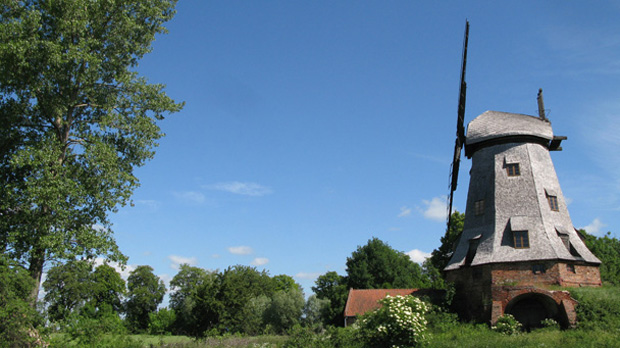Village News
Poland: Part II

Another part of my trip to Poland this last June was participation in a documentary being created by Steinbach’s Laszlo Markovics for the MTS “My Manitoba” series. The topic is Mennonite windmills, based on our 2013 theme. The cameraman for the documentary met me in Poland at the Chrystkowo site, an open-air museum, and I interviewed my guide and Mennonite scholar Wojceich Marchlewski for the film regarding Mennonites, windmills, land-use and water management. The film is currently being edited and should be complete in November.
A number of visitors, including myself, were then taken up in a small 4-seater plane to view the landscape, in particular the “Trifften” (land strips) that Mennonites helped develop in the region and are still used in some areas.
The next morning was spent at the windmill at Palczewo, in northern Poland about 10 KM west of Elblag, where we filmed more footage for the documentary. We were able to get the keys to the windmill and photographed and taped the interior and exterior. The windmill contained 5 levels, not including the cap, and was used to mill, clean, sift and pack flour, complete with an “elevator” system.
We then went to Nowy Dwor Gdansk (formerly Tiegenhof) and visited the Zulawski Museum, which exhibits the history of the region (including windmills and furniture), with the entire second floor dedicated to Mennonite history.
Afterwards we drove to the former settlement of Ellerwald (where some Sawatzkys lived in the 1650s), a Mennonite group of villages west of Elblag (Elbing) in the Vistula Delta. The fields were low-lying “polder”, protected by dikes and previously drained exclusively by windmills.
We were also able to visit Malbork Castle (Malberg), the centre of the Teutonic Knights’ region of control, which was the forerunner of Prussia.
We visited Torun, the site of a new Mennonite open-air museum. There is now a new “Mennonite Street”, where the Torun Mennonite cemetery is located and a Mennonite housebarn is being reconstructed. This structure is about 95% new materials, but it includes a number of original elements and is based entirely on the original floor plan and construction details.
On my last day, we visited the former Mennonite village now known as Nowy Wymysle. This village has numerous excellent examples of Mennonite housebarn architecture, as well as a dilapidated school house, cemetery and MB church (1865). This village was extensively studied and recorded by Marchlewski in the 1980s, but has since become quite dilapidated, with some of the houses having disappeared. Very poor families live in the homes.
I would like to thank my guide and translator, Wojceich Marchlewski, without whom this trip would simply not have been possible.




